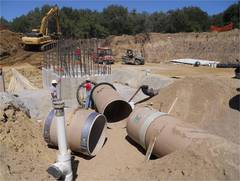Illinois WWTP Prepares for the Future
The $125 million upgrade and expansion were designed to meet regulatory requirements and future demand. The project was funded through a Water Pollution Control Loan, using both state and American Recovery and Reinvestment money. Crawford, Murphy and Tilly (CMT) of Springfield, Ill. was selected to provide design and construction management for the Spring Creek WWTP Improvement project.
The project consisted of four phases. Phases One and Two were bid as two contracts, both awarded to River City Construction of East Peoria, Ill., who subcontracted the pipe installation to Petersburg Plumbing and Heating of Petersburg, Ill. Phase Three was awarded to Plocher Construction of Highland, Ill., who subcontracted the pipe installation to Davis-Houk Mechanical of Urbana, Ill.
Hobas Pipe USA provided 418 feet of 84-inch diameter centrifugally cast, fiberglass reinforced, polymer mortar (CCFRPM) pipe for Phases One and Two. For Phase Three, Hobas provided 5,120 feet of pipe ranging in diameter from 48 to 84 inches.
“Initially we were only specified for 2,435 feet of 54- through 84-inch,” explained Vince Paparozzi, area manager-north central, Hobas Pipe USA. Davis-Houk value engineered an additional 2,685 feet of 48-inch pipe, which was a change from the job bid when all 48-inch and smaller was specified as ductile iron.”
“Hobas Pipe USA and Davis-Houk Mechanical inquired if the owner (SMSD) would be receptive to utilizing Hobas pipe and fittings for the 48-inch pipe,” stated Raed Armouti, P.E., field services manager for CMT. “We recommended this change and the owner agreed to entertain this proposal. Based on the substantial cost savings for using 48-inch Hobas pipe and fittings instead of ductile iron, the owner agreed to the change.
The cost savings were due to economical Hobas pipe and fittings materials cost and the associated installation costs. Hobas pipe and fittings are much lighter than ductile iron, so smaller equipment could be used for the installation operations,” concluded Armounti. Fiberglass fittings can be constructed in almost any configuration and angle. Numerous fittings, such as wyes, reducers, tees and elbows were supplied for Phase Three.
The maximum depth of the buried pipeline was 21 feet with a minimum depth of 2.5 feet. The high stiffness design of the Hobas 46-psi pipes was suitable to handle the deep covers and also handle potentially high live HS-20 traffic loads at shallow covers.
“The native soils are silty clay,” explained Armouti. “We used granular backfill from four inches below the bottom of the pipe to 12 inches above the top of pipe. This was IDOT FA-1 sand that was compacted to 98 percent Proctor by water jetting. We were comfortable that the granular bedding provided the 46-stiffness pipe with the required support for the 21-foot depth that we have.”
An expansion to an existing WWTP can be difficult to completely design ahead of time. Exact connections to existing structures sometimes are not known until the project is underway and the ground area around the structures is removed.
“A lot of field cutting of pipe was done to hit structures,” explained Chad Graham, project manager, Davis-Houk Mechanical. “Hobas provided many custom fittings on the clarifiers to help field installation. Hobas provided 95 fittings for this WWTP expansion. Custom fittings such as special angle elbows, reducers and wyes were designed. Fairly standard 45- and 90-degree elbows were also modified with longer than normal lay lengths to minimize field cuts. Overall, the fitting schedule was very complicated; but installation was simplified by the custom pieces and field versatility.”
“Due to the pipe’s fixed outside diameter and a fixed inside diameter seal on the FWC couplings, field adjustments to the standard 20-foot pipe lengths are easily accomplished to connect to concrete structures or a fitting,” explained Rene Garcia, engineering supervisor, Hobas Pipe USA.
This project utilized stainless steel closures, which minimized the amount of ground removal. Graham explained further, “The stainless steel closure couplings were required between two fixed ends. In most cases, we had a large concrete diversion structure and multiple concrete clarifiers with interconnecting piping between the structures. The closure couplings allowed each of the concrete structures to be constructed independently of each other, allowing Plocher Construction to erect multiple structures at once without dividing the side up with our excavation work. Each structure had multiple cast-in-place Hobas sleeves or fittings. Once the structures were complete and the concrete equipment removed from the direct area, the intermediate piping was completed, connecting to the Hobas sleeves at each structure or cast-in-place fitting.”
As required, the force main was tested at 25 psi and gravity piping was tested at 20 psi for one minute without leakage or pressure drop. “We are about 85 percent complete with testing and only had one joint seal issue on a closure coupling,” stated Graham. “Hobas is planning on coming in after we are 100 percent tested and seal the joint from the inside. That’s the benefit to using Hobas pipe — we will not have to dig up the coupling for repair since the site is now restored.”
“Fiberglass pipes by nature are very repairable,” stated Kimberly Paggioli, P.E., vice president, marketing and quality control, Hobas Pipe USA. The same materials that are utilized to make all of the custom fittings for this project can be utilized to seal the leaking joint internally. Davis-Houk used joint testers from Plug It Products.
Springfield WWTP is one of three Illinois EPA funded projects for which Hobas has supplied pipe. The others include the Southside Intercepting Sewer in Wheaton, Ill. (13,000 feet of 48-inch) and the Kickapoo Creek Sewer in Downs, Ill. (18,000 feet of 36-inch).

